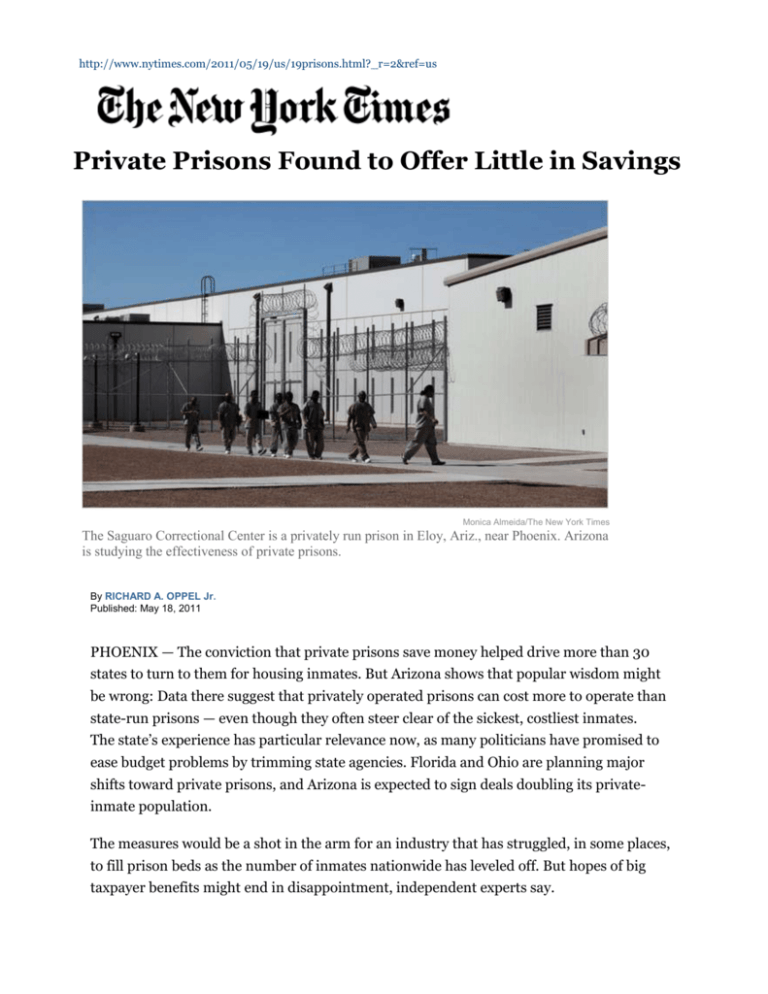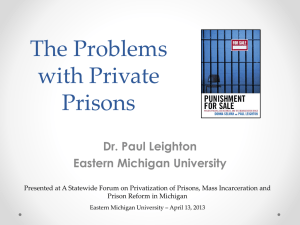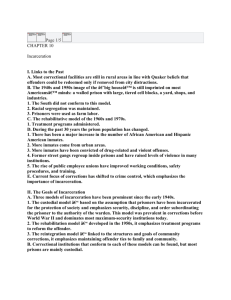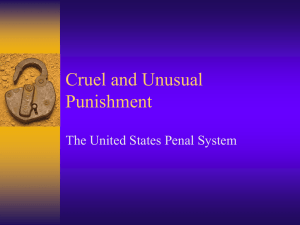Private Prisons Found to Offer Little in Savings
advertisement

http://www.nytimes.com/2011/05/19/us/19prisons.html?_r=2&ref=us Private Prisons Found to Offer Little in Savings Monica Almeida/The New York Times The Saguaro Correctional Center is a privately run prison in Eloy, Ariz., near Phoenix. Arizona is studying the effectiveness of private prisons. By RICHARD A. OPPEL Jr. Published: May 18, 2011 PHOENIX — The conviction that private prisons save money helped drive more than 30 states to turn to them for housing inmates. But Arizona shows that popular wisdom might be wrong: Data there suggest that privately operated prisons can cost more to operate than state-run prisons — even though they often steer clear of the sickest, costliest inmates. The state’s experience has particular relevance now, as many politicians have promised to ease budget problems by trimming state agencies. Florida and Ohio are planning major shifts toward private prisons, and Arizona is expected to sign deals doubling its privateinmate population. The measures would be a shot in the arm for an industry that has struggled, in some places, to fill prison beds as the number of inmates nationwide has leveled off. But hopes of big taxpayer benefits might end in disappointment, independent experts say. “There’s a perception that the private sector is always going to do it more efficiently and less costly,” said Russ Van Vleet, a former co-director of the University of Utah Criminal Justice Center. “But there really isn’t much out there that says that’s correct.” Such has been the case lately in Arizona. Despite a state law stipulating that private prisons must create “cost savings,” the state’s own data indicate that inmates in private prisons can cost as much as $1,600 more per year, while many cost about the same as they do in staterun prisons. The research, by the Arizona Department of Corrections, also reveals a murky aspect of private prisons that helps them appear less expensive: They often house only relatively healthy inmates. “It’s cherry-picking,” said State Representative Chad Campbell, leader of the House Democrats. “They leave the most expensive prisoners with taxpayers and take the easy prisoners.” In the 1980s, soaring violent crime, tougher sentencing and overcrowding led lawmakers to use private prisons to expand. Joshua Lott for The New York Times State Representative Chad Campbell of Arizona said private prisons “leave the most expensive prisoners with taxpayers.” Then, as now, privatization advocates argued that corporations were more efficient. Over time, most states signed contracts, one of the largest transfers of state functions to private industry. Nationally, the number of state inmates in private prisons grew by a third over the past decade to more than 90,000, but it has stagnated, and some states have reduced total prison populations — shifting nonviolent offenders to treatment programs while bolstering probation. Now, Ohio lawmakers want to privatize prisons with 6,000 inmates, and Florida will transfer institutions with 15,000 inmates to private management. The Arizona plan would add 5,000 private prison beds. Matthew Benson, spokesman for Gov. Jan Brewer of Arizona, a Republican, did not dispute the state research. But he said officials had a “pretty wide lens” to interpret the cost-savings mandate, like taking into account the ability of private companies to recoup hundreds of millions in construction costs over the life of contracts. “It is a significant advantage to have a private firm be able to come in and front the costs,” he said. 2 Privatization advocates play down the data. Leonard Gilroy, director of government reform for the Reason Foundation, a libertarian research organization, questioned whether all costs were included and said the figures were too narrowly drawn, particularly on mediumsecurity prisons, to prompt conclusions. “It is looking at a limited slice,” Mr. Gilroy said. Competing studies — some financed by the prison industry — have argued over claims of savings. But when a University of Utah team including Mr. Van Vleet reviewed years of research, it concluded in 2007 that “cost savings from privatizing prisons are not guaranteed and appear minimal.” Steve Owen, spokesman for the largest operator, Corrections Corporation of America, said: “There is a mixed bag of research out there. It’s not as black and white and cut and dried as we would like.” A number of states mandate that contracts save money. But Arizona is one of the few — if not only — places to measure the outcome so rigorously. While private prisons collect a daily rate per inmate, some expenses disproportionately borne by states are not counted. The most significant are terms limiting sicker inmates. Five of eight private prisons serving Arizona did not accept inmates with “limited physical capacity and stamina” or severe physical illness or chronic conditions, according to the state’s analysis, issued last month. None took inmates with “high need” mental health conditions. Some inmates who became sick were “returned to state prisons due to an increase of their medical scores that exceeds contractual exclusions.” “Unlike the private contractors,” the analysis said, the state “is required to provide medical and mental health services to inmates regardless of the severity of their condition.” Medical costs averaged up to $2.44 a day more for state inmates, a third higher than private prisons. That gap can be wider. In Florida, officials found that two private prisons spent only about half as much on health care per inmate as comparable state prisons, a difference of $9 million over two years. Florida officials say that the new plan will better balance costs, and that private prisons comply with a 7-percent-savings law. But skeptics like State Senator Mike Fasano, a Republican, fear cherry-picking may be the only way they can do that. In Arizona, minimum-security state inmates cost 2.6 percent — or $1.39 per day — more than those in private prisons, before accounting for extra costs borne by the state. But after eliminating these, state prisoners cost only three cents more per day, the analysis found. 3 And state medium-security inmates cost 4.4 percent less before adjustments and 8.7 percent less afterward. That is more than $2 million annually at one prison, or $1,679 per inmate. Using 2009 corrections data, state auditors calculated the difference at up to $2,834 per inmate. Charles L. Ryan, the Arizona corrections director, said private prisons “often negotiate restrictions on the type of inmates” and limit “inmates with medical conditions to a specific cost level.” The new contracts seek to reduce this practice. Mr. Owen did not dispute the Arizona research, but said the industry saved money. He pointed to a study — partly financed by the industry — that found states with private prisons had lower growth in public prison costs. “We do provide value to our government partners,” he said. However, Mr. Owen acknowledged that most contracts had cost caps, and that terms barring the sickest prisoners were not unusual. He said his company never voiced a preference for such terms. “The myth is that we are somehow hand-selecting” inmates. According to Arizona officials, the data account for costs as varied as guards’ pensions and inmate food. They track past results publicized in the state, but those have not prompted any privatization rethinking: contracts on the state’s expansion could be awarded by the summer. A version of this article appeared in print on May 19, 2011, on page A1 of the New York edition with the headline: Private Prisons Found to Offer Little in Savings. http://www.nytimes.com/2011/05/19/us/19prisons.html?_r=2&ref=us 4







